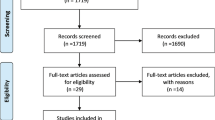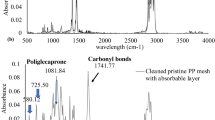Abstract
Purpose
The aim of this study was to classify the polymeric prosthetics used for hernia repair based on biomaterial composition and weight in an effort to clarify to surgeons what kinds of material they are dealing with and to provide a standardized system of categorization.
Materials and methods
An intensive research effort was carried out on prosthetics that are commercially available worldwide. We conducted a search of the medical literature and companies’ websites to find the weights and thicknesses of commercially available prosthetics. Where these data were lacking, we contacted manufacturers directly in order to render the research more complete. A total of 166 products were considered for classification based on biomaterial properties. Among these, a homogeneous group of 80 polypropylene monofilament knitted or woven prosthetics was selected for classification based on weight. Weights were provided for 70 prosthetics (87%), and both the weight and thickness was provided for 40 prosthetics (50%).
Results
Classification based on weight: Ultra-light <35 g/m2, Light ≥35 < 70 g/m2, Standard ≥70 < 140 g/m2, Heavy ≥140 g/m2. Classification based on biomaterial composition: simple (prosthetics made of one pure biomaterial); composite (prosthetics made of two or more different layers); combined (prosthetics made of two materials knitted or woven together); and biologic.
Conclusion
Weight and biomaterial classifications were proposed after an extensive analysis of commercially available prosthetics. The need for a common terminology is important to avoid misunderstandings among clinicians and technicians.


Similar content being viewed by others
References
Melick DW (1942) Nylon sutures. Ann Surg 115:475–476
Aquaviva D, Bounet P (1944) Cure d’une volumineuse eventration par plaque de Crinofil. Extraits Bull Soc Chir de Marseille 1944. quoted by Zagdoun J–Sordinas A, L’utilisation des plaques de nylon dans la chirurgie des hernies inguinales, Academie de Chirurgie, Sèance du 25 Nov 1959, 747–54
Maloney GE, Gill WG, Barclay RC (1948) Operations for hernia: technique of nylon darn. Lancet 2:45–48
Usher FC, Wallace SA (1958) Tissue reaction to plastic: comparison of Nylon, Orlon, Teflon and Dacron. Arch Surg 76:997–999
Usher FC, Ochsner J, Tuttle LLD (1959) Marlex mesh: a new plastic mesh for replacing tissue defects, experimental studies. Am Surg 24(12):969–974
Usher FC (1961) Knitted Marlex mesh. An improved Marlex prosthesis for repairing hernias and other tissue defects. Arch Surg 82:771–773
King MW, Soares BM, Guidoin R (1994) The chemical, physical and structural properties of synthetic biomaterials used in hernia repair. In: Bendavid R (ed) Prostheses and abdominal wall hernias. Landes, Austin, pp 191–206
Klinge U, Klosterhalfen B, Schumpelick V (2001) Vypro®: a new generation of Polypropylene Mesh. In: Bendavid R et al (eds) Abdominal wall hernias: principles and management. Springer, New York, pp 286–291
Udwadia TE (2007) Commercial mesh versus nylon mosquito net for hernia repair. A randomized double-blind study in Burkina Faso. World J Surg 31(4):858. [http://www.ncbi.nlm.nih.gov/pubmed/16983472]
Wilhelm TJ (2007) Sterilized mosquito net versus commercial mesh for hernia repair. an experimental study in goats in Mbarara/Uganda. Eur Surg Res 39(5):312–317. [http://www.ncbi.nlm.nih.gov/pubmed/17595545]
Clarke MG (2009) The use of sterilised polyester mosquito net mesh for inguinal hernia repair in Ghana. Hernia 13(2):155–159. doi:10.1007/s10029-008-0460-3. [http://www.springerlink.com/content/u147um764l3j4227/]
Schumpelick V, Klinge U, Rosch R, Junge K (2006) Light weight meshes in incisional hernia repair. J Min Access Surg 2(3):117–123
Klingensmith ME, Chen LE, Glasgow SC, Goers TA (eds) (2007) Hernias. In: The Washington manual of surgery. Lippincott Williams & Wilkins, Philadelphia, pp 442–452
The significance of a mesh thickness in the operation of inguinal hernia (2007–2009) [http://clinicaltrials.gov/ct2/show/NCT00451893]
ftp://ftp.polito.it/people/cesal/Polimeri_Medicina/Trombetta.pdf
Klosterhalfen B, Junge K, Klinge U (2005) The lightweight and large porous mesh concept for hernia repair. Expert Rev Med Devices 2(1):103–117
Kraft B (2006) Meshes and mesh-fixation techniques in TAPP hernia-repair. Surg Laparosc Endosc Percutan Tech 16(6):448–449
Horstmann R (2006) Impact of polypropylene amount on functional outcome and quality of life after inguinal hernia repair by the TAPP procedure using pure, mixed, and titanium-coated meshes. World J Surg 30:1–8
Lauscher JC (2008) Total extraperitoneal hernioplasty: does the long-term clinical course depend on the type of mesh? J Laparoendosc Adv Surg Tech 18:6–9
Karsten J (2002) Functional and morphologic properties of a modified mesh for inguinal hernia repair. World J Surg 26(12):1472–1480
Schmidbauer S, Ladurner R, Hallfeldt KK, Mussack T (2005) Heavy-weight versus low-weight polypropylene meshes for open sublay mesh repair of incisional hernia. Eur J Med Res 10:247–253
Schug-Paß C, Tamme C, Sommerer F, Tannapfel A, Lippert H, Köckerling F (2008) A lightweight, partially absorbable mesh (Ultrapro) for endoscopic hernia repair: experimental biocompatibility results obtained with a porcine model. Surg Endosc 22:1100–1106
Holzheimer RG (2004) First results of Lichtenstein hernia repair with Ultrapro-mesh as cost saving procedure—quality control combined with a modified quality of life questionnaire (SF-36) in a series of ambulatory operated patients. Eur J Med Res 9(6):323–327
Khan LR, Liong S, de Beaux AC, Kumar S, Nixon SJ (2010) Lightweight mesh improves functional outcome in laparoscopic totally extra-peritoneal inguinal hernia repair. Hernia 14:39–45
Smietański M, Bigda J, Zaborowski K, Worek M, Sledziński Z (2009) Three-year follow-up of modified Lichtenstein inguinal hernioplasty using lightweight poliglecaprone/polypropylene mesh. Hernia 13:239–242
Zieren J, Neuss H, Ablassmaier B, Müller JM (2002) Adhesions after intraperitoneal mesh repair in pigs: Prolene™ vs. Vypro™. J Laparoendosc Adv Surg Tech A 12(4):249–252
Tamme C, Garde N, Klingler A, Hampe C, Wunder R, Köckerling F (2005) Totally extraperitoneal inguinal hernioplasty with titanium-coated lightweight polypropylene mesh: early results. Surg Endosc 19(8):1125–1129
Anderson JR (2006) Ultralightweight Polypropylene mesh for abdominal wall hernia repair. Annual Conference of the British Hernia Society, Abstract Book, British Hernia Society, Nottingham
Cobb WS et al (2006) Textile analysis of heavy weight, mid-weight, and light weight polypropylene mesh in a porcine ventral hernia model. J Surg Res 136(1):1–7
Earle DB, Mark LA (2008) Prosthetic material in inguinal hernia repair: how do I choose? Surg Cl N Am 88:179–201
Cobb WS, Peindl RM, Zerey M, Carbonell AM, Heniford BT (2009) Mesh terminology 101. Hernia 13:1–6
Acknowledgments
This paper concerning the classification of prosthetics used in hernia repair has been developed with the co-operation with Herniamesh Srl, [Via Fratelli Meliga 1/C, Chivasso (TO), Italy].
Declaration
The authors apologize in advance for any imprecision, oversight or omission about products and companies and kindly request that companies contact them with any suggestions or comments that will further improve upon the database. A.C. declares that he received no grant support for this work.
Author information
Authors and Affiliations
Corresponding author
Rights and permissions
About this article
Cite this article
Coda, A., Lamberti, R. & Martorana, S. Classification of prosthetics used in hernia repair based on weight and biomaterial. Hernia 16, 9–20 (2012). https://doi.org/10.1007/s10029-011-0868-z
Received:
Accepted:
Published:
Issue Date:
DOI: https://doi.org/10.1007/s10029-011-0868-z




